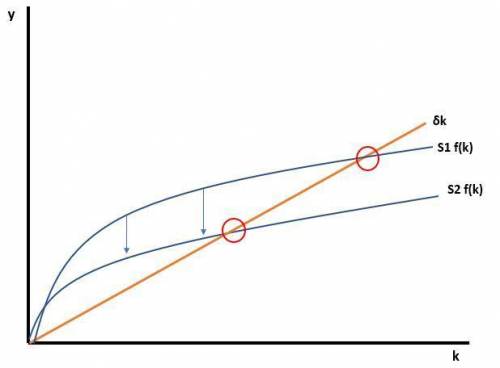
Business, 03.09.2019 18:30 Porciabeauty6788
If two economies are identical (with the same population growth rates and rates of technological progress), but one economy has a lower saving rate, then the steady-state level of income per worker in the economy with the lower saving rate: a. will be at a lower level than the steady state of the high-saving economy. b. will be at a higher level than the steady state of the high-saving economy. c. will be at the same level as the steady state of the high-saving economy. d. will grow at a slower rate than the high-saving economy

Answers: 2
Another question on Business

Business, 21.06.2019 23:00
How supply and demand work together to reach the equilibrium price in the marketplace? give at least a paragraph. you!
Answers: 3

Business, 22.06.2019 01:00
Data pertaining to the current position of forte company are as follows: cash $437,500 marketable securities 170,000 accounts and notes receivable (net) 320,000 inventories 700,000 prepaid expenses 42,000 accounts payable 240,000 notes payable (short-term) 250,000 accrued expenses 310,000 required: 1. compute (a) the working capital, (b) the current ratio, and (c) the quick ratio. round ratios to one decimal place. 2. compute the working capital, the current ratio, and the quick ratio after each of the following transactions, and record the results in the appropriate columns of the table provided. consider each transaction separately and assume that only that transaction affects the data given. round to one decimal place. a. sold marketable securities at no gain or loss, 75,000. b. paid accounts payable, 135,000. c. purchased goods on account, 100,000. d. paid notes payable, 105,000. e. declared a cash dividend, 125,000. f. declared a common stock dividend on common stock, 45,000. g. borrowed cash from bank on a long-term note, 205,000. h. received cash on account, 130,000. i. issued additional shares of stock for cash, 635,000. j. paid cash for prepaid expenses, 15,000.
Answers: 3

Business, 22.06.2019 07:50
In december of 2004, the company you own entered into a 20-year contract with a grain supplier for daily deliveries of grain to its hot dog bun manufacturing facility. the contract called for "10,000 pounds of grain" to be delivered to the facility at the price of $100,000 per day. until february 2017, the supplier provided processed grain which could easily be used in your manufacturing process. however, no longer wanting to absorb the cost of having the grain processed, the supplier began delivering whole grain. the supplier is arguing that the contract does not specify the type of grain that would be supplied and that it has not breached the contract. your company is arguing that the supplier has an onsite processing plant and processed grain was implicit to the terms of the contract. over the remaining term of the contract, reshipping and having the grain processed would cost your company approximately $10,000,000, opposed to a cost of around $1,000,000 to the supplier. after speaking with in-house counsel, it was estimated that litigation would cost the company several million dollars and last for years. weighing the costs of litigation, along with possible ambiguity in the contract, what are three options you could take to resolve the dispute? which would be the best option for your business and why?
Answers: 2

Business, 22.06.2019 13:40
Salge inc. bases its manufacturing overhead budget on budgeted direct labor-hours. the variable overhead rate is $8.10 per direct labor-hour. the company's budgeted fixed manufacturing overhead is $74,730 per month, which includes depreciation of $20,670. all other fixed manufacturing overhead costs represent current cash flows. the direct labor budget indicates that 5,300 direct labor-hours will be required in september. the company recomputes its predetermined overhead rate every month. the predetermined overhead rate for september should be:
Answers: 3
You know the right answer?
If two economies are identical (with the same population growth rates and rates of technological pro...
Questions

History, 22.02.2020 23:04

Physics, 22.02.2020 23:04

Mathematics, 22.02.2020 23:04


Mathematics, 22.02.2020 23:04

Mathematics, 22.02.2020 23:04


Mathematics, 22.02.2020 23:05

Mathematics, 22.02.2020 23:05


Mathematics, 22.02.2020 23:05

Chemistry, 22.02.2020 23:05



Mathematics, 22.02.2020 23:06

Mathematics, 22.02.2020 23:06

Biology, 22.02.2020 23:06


English, 22.02.2020 23:07

Mathematics, 22.02.2020 23:08




